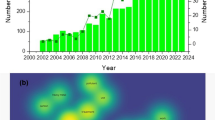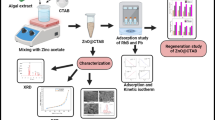Abstract
A novel chelate sorbent (bis-3,4-dihydroxybenzy)p-phenylen diamine-grafted hydrothermal carbon spheres (HCS-BDBPD) had been successfully synthesized through chemical grafting method. FT-IR and SEM were used to analyze the chemical and microscopy structure of HCS-BDBPD. The batch experiments were carried out to study uranium adsorption properties of HCSs-BDBPD aimed at confirming the optimum condition for removal uranium from waste. The result showed that the sorption process was spontaneous and endothermic in nature and the maximum uranium sorption capacity of 272 mg/g was obtained under the conditions tested, the selectivity of HCSs toward uranium was improved after grafting BDBPD groups on the surface of HCSs.













Similar content being viewed by others
References
Giri S, Singh G, Gupta SK, Jha VN, Tripathi RM (2010) An evaluation of metal contamination in surface and groundwater around a proposed uranium mining site, Jharkhand, India. Mine Water Environ 3:225–234
Singh SP, Hendry MJ (2012) Solid-phase distribution and leaching Behaviour of nickel and uranium in a uranium waste-rock piles. Water Air Soil Pollut 224(1):1–11
Biswas S, Pathak PN, Singh DK, Roy SB, Manchanda VK (2011) Mathematical modeling of solvent extraction of uranium from sulphate media employing 2-ethylhexyl phosphonic acid-mono-2-ethylhexyl ester (PC88A) and its mixture with trioctylphosphine oxide (TOPO) as extractants. J Radioanal Nucl Chem 2:557–564
Bermudez GMA, Moreno M, Invernizzi R (2010) Evaluating top soil trace element pollution in the vicinity of a cement plant and a former open-cast uranium mine in central Argentina. J Soils Sediments 7:1308–1323
Marshall TA, Morris K, Law GTW, Livens FR, Mosselmans JFW, Bots P, Shaw S (2014) Incorporation of uranium into hematite during crystallization from ferrihydrite. Environ Sci Technol 7:3724–3731
Gallegos TJ, Fuller CC, Webb SM, Betterton W (2013) Uranium(VI) interactions with mackinawite in the presence and absence of bicarbonate and oxygen. Environ Sci Technol 13:7357–7364
Ohnuki T, Ozaki T, Yoshida T, Sakamoto F, Kozal N, Wakal E, Francis AJ, Iefuji H (2005) Mechanisms of uranium mineralization by the yeast Saccharomyces cerevisiae. Geochim Cosmochim Acta 22:5307–5316
Alexandratos SD (2009) Ion-exchange resins: a retrospective from industrial and engineering Chemistry research. Ind Eng Chem Res 1:388–398
Zagorodnyaya AN, Abisheva ZS, Sharipova AS, Sadykanova SE, Bochevskaya YG, Atanova OV (2013) Sorption of rhenium and uranium by strong base anion exchange resin from solutions with different anion compositions. Hydrometallurgy 131–132(1):127–132
Li ZJ, Wang L, Yuan LY, Xiao CL, Mei L, Zheng LR, Zhang J, Yang JH, Zhao YL, Zhu ZT, Chai ZF, Shi WQ (2015) Efficient removal of uranium from aqueous solution by zero-valent iron nanoparticle and its graphene composite. J Hazard Mater 290:26–33
Pulhani VA, Dafauti S, Hegde AG (2011) Separation of uranium from iron in ground water samples using ion exchange resins. J Radioanal Nucl Chem 2:299–302
Nikoloski AN, Ang KL (2013) Review of the application of ion exchange resins for the recovery of platinum-group metals from hydrochloric acid solutions. Miner Process Extr Metall Rev 6:369–389
Yu XF, Liu YH, Zhou ZW, Xiong GX, Cao XH, Li M, Zhang ZB (2014) Adsorptive removal of U(VI) from aqueous solution by hydrothermal carbon spheres with phosphate group. J Radioanal Nucl Chem 3:1235–1244
Zhang WL, Zhang ZB, Cao XH, Ma RC, Liu YH (2014) Uranium adsorption studies on hydrothermal carbon produced by chitosan using statistical design method. J Radioanal Nucl Chem 301:197–205
Zou YD, Cao XH, Luo XP, Liu Y, Hua R, Liu YH, Zhang ZB (2015) Recycle of U(VI) from aqueous solution by situ phosphorylation mesoporous carbon. J Radioanal Nucl Chem 2:515–525
Nie WB, Zhang ZB, Cao XH, Liu YH, Liang P (2012) Sorption study of uranium from aqueous solution on ordered mesoporous carbon CMK-3. J Radioanal Nucl Chem 1:663–670
Tian G, Geng JX, Jin YD, Wang CL, Li SQ, Chen Z, Wang H (2011) Sorption of uranium(VI) using oxime-grafted ordered mesoporous carbon CMK-5. J Hazard Mater 1–3:442–450
Zhang ZB, Zhou ZW, Cao XH, Liu YH, Xiong GX, Liang P (2013) Removal of uranium(VI) from aqueous solutions by new phosphorus-containing carbon spheres synthesized via one-step hydrothermal carbonization of glucose in the presence of phosphoric acid. J Radioanal Nucl Chem 3:1479–1487
Yung MC, Ma J, Phinney MRBS, Bowman GR, Jiao Y (2014) Shotgun proteomic analysis unveils survival and detoxification strategies by Caulobacter crescentus during exposure to uranium, chromium, and cadmium. J Proteome Res 4:1833–1847
Kumar J, Mallampati R, Adin A, Valiyaveettil S (2014) Functionalized carbon spheres for extraction of nanoparticles and catalyst support in water. ACS Sustainable Chem Eng 12:2675–2682
Bhatta LKG, Subramanyam S, Chengala MD, Bhatta UM, Venkatesh K (2015) Enhancement in CO2 adsorption on hydrotalcite-based material by novel carbon support combined with K2CO3 impregnation. Ind Eng Chem Res 54(43):10876–10884
Wang H, Ma LJ, Cao KC, Geng JX, Liu J, Song Q, Yang XD, Li SJ (2012) Selective solid-phase extraction of uranium by salicylideneimine-functionalized hydrothermal carbon. J Hazard Mater 229:321–330
Chen YQ, Guo JL (2014) Reversible oxidation of graphene through ultraviolet/ozone treatment and its nonthermal reduction through ultraviolet irradiation. J Phys Chem C 118(47):6407–6412
Titirici MM, Antonietti M (2010) Chemistry and materials options of sustainable carbon materials made by hydrothermal carbonization. Chem Soc Rev 1:103–116
Zhang ZB, Nie WB, Li Q, Xiong GX, Cao XH, Liu YH (2013) Removal of uranium(VI) from aqueous solutions by carboxyl-rich hydrothermal carbon spheres through low-temperature heat treatment in air. J Radioanal Nucl Chem 1:361–368
Bi C, Fang Y, Sun G, Chang J (1999) Synthesis and characterization of Th(IV) and U (VI) complexes with o-vanillin-p-phenylenediamine. J Radioanal Nucl Chem 246(1):221–223
Zhang ZB, Liu YH, Cao XH, Liang P (2012) Sorption study of uranium on carbon spheres hydrothermal synthesized with glucose from aqueous solution. J Radioanal Nucl Chem 3:1775–1782
Fanning PE, Vannice MA (1993) A drifts study of the formation of surface groups on carbon by oxidation. Carbon 31(93):721–730
Sun X, Li Y (2005) Ag@ C core/shell structured nanoparticles: controlled synthesis, characterization and assembly. Langmuir 21(13):6019–6024
Chen Z, Ma L, Li S, Geng S, Song Q, Liu J (2011) Simple approach to carboxyl-rich materials through low-temperature heat treatment of hydrothermal carbon in air. Appl Surf Sci 257(20):8686–8691
Zhang CX, Ren ZY, Yin ZG, Qian HY, Ma DZ (2007) Amide II and amide III bands in polyurethane model soft and hard segments. Polym Bull 1:97–101
Mamatov GZ, Yagu MR (1968) Integral intensities of the infrared bands due to the stretching. J Appl Spectrosc 8(5):825–829
O’Bannon E, Williams Q (2015) Vibrational spectra of four polycyclic aromatic hydrocarbons under high pressure: implications for stabilities of PAHs during accretion. Phys Chem Miner 66(4):872–875
Kross RD, Fassel VA, Margosiies M (1956) The infrared spectra of aromatic compounds. 11. evidence concerning the interaction of r-electrons and a-bond orbitals in C-H out-of-plane bending vibrations. J Am Chem Soc 78(7):1332–1335
Gu ZX, Wang Y, Tang J, Yang JJ, Liao JL, Yang YY, Liu N (2014) The removal of uranium(VI) from aqueous solution by graphene oxide–carbon nanotubes hybrid aerogels. J Radioanal Nucl Chem 303(3):1835–1842
Cheng HG, Zeng KF, Yu JT (2013) Adsorption of uranium from aqueous solution by graphene oxide nanosheets supported on sepiolite. J Radioanal Nucl Chem 1:599–603
Liu SJ, Ma JG, Zhang WQ, Luo F, Luo MB, Li FQ, Wu LP (2015) Three-dimensional graphene oxide/phytic acid composite for uranium(VI) sorption. J Radioanal Nucl Chem 2:507–514
Zhang ZB, Cao XH, Liang P, Liu YH (2012) Adsorption of uranium from aqueous solution using biochar produced by hydrothermal carbonization. J Radioanal Nucl Chem 2:1201–1208
Tan LC, Liu Q, Song DL, Jing XY, Liu JY, Li RM, Hu SX, Liu LH, Liu J (2015) Uranium extraction using a magnetic CoFe2O4–graphene nanocomposite: kinetics and thermodynamics studies. New J Chem 4:2832–2838
Li B, Ma L, Tian Y (2014) A catechol-like phenolic ligand-functionalized hydrothermal carbon: one-pot synthesis, characterization and sorption behavior toward uranium. J Hazard Mater 271:41–49
Wang H, Ma L, Cao K, Geng J, Liu J, Song Q, Li S (2012) Selective solid-phase extraction of uranium by salicylideneimine-functionalized hydrothermal carbon. J Hazard Mater 229:321–330
Acknowledgments
This work was financially supported by the National Basic Research Program of China (No. 2014CB460604), the National Natural Science Foundation of China (Grant No. 21301028, 11475044, 41461070, 21561002), the Program for Changjiang Scholars and Innovative Research Team in University (Grant No. IRT13054), the Science & Technology Support Program of Jiangxi Province (Grant No. 20141BBG70001, 20151BBG70010), the Advanced Science & Technology Innovation Team Program of Jiangxi Province (Grant No. 20142BCB24006), and the Innovation Team Program of Jiangxi Provincial Department of Science and Technology (Grant No. 2014BCB24006).
Author information
Authors and Affiliations
Corresponding authors
Rights and permissions
About this article
Cite this article
Lai, Zj., Zhang, Zb., Cao, Xh. et al. Synthesis of novel functional hydrothermal carbon spheres for removal of uranium from aqueous solution. J Radioanal Nucl Chem 310, 1335–1344 (2016). https://doi.org/10.1007/s10967-016-5003-2
Received:
Published:
Issue Date:
DOI: https://doi.org/10.1007/s10967-016-5003-2




